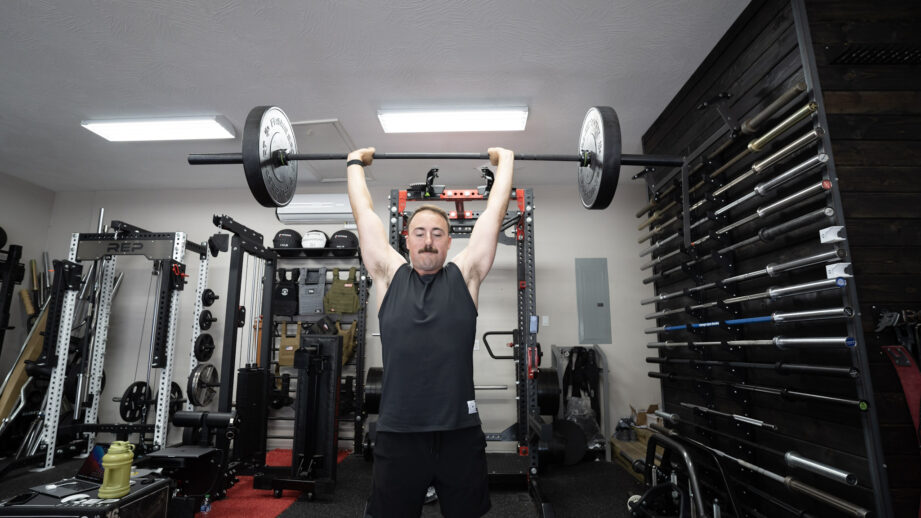We test and review fitness products based on an independent, multi-point methodology. If you use our links to purchase something, we may earn a commission. Read our disclosures.
So you got a barbell for your home gym. Congrats on making one of the best purchases—no, investments—for yourself, your health, and your home gym. While every home gym is a good gym, I personally don’t think a home gym is complete without an Olympic barbell and a set of weight plates.
Barbell training tops the list of training methods that are versatile and effective. Not only will barbell workouts increase muscle mass, power, and strength, they’ll also contribute to better body awareness and overall health and fitness. You can use a barbell to train your upper body, lower body, and even your core. Use it to develop explosiveness or muscular endurance. Whatever your goals, a barbell can help get you there.
Related: Personal training apps
Best Barbell Exercises
Back Squat
Back squats are like the holy grail of strength training. They train one of the most foundational movement patterns humans can possibly engage in. We squat to sit down. We squat to talk to kids. We squat to … um … use the facilities. We are literally always squatting in day-to-day life.
What muscles do back squats work?
The primary movers for back squats include all of the muscles involved in hip flexion and extension, which include the quadriceps, hamstrings, hip abductors (glutes), and hip adductors (inner thighs). Hip extension is the opening or lengthening of your hips, while hip flexion is the closing or shortening of your hips—think bringing your knee to your chest (flexion) and then putting it back down (extension). Your calves, feet, core, back, and even your arms and shoulders engage during barbell back squats.
Benefits of back squats
Barbell back squats are one of the best exercises to help you build strength. They strengthen your entire posterior chain, teach you how to maintain a strong core, increase hip and ankle mobility, and contribute to muscle growth in your lower body.
How to do a back squat:
- Setup: Rack a bar on a squat rack or power cage at about shoulder height. Add your weight plates.
- Starting position: Unrack the barbell onto your shoulders and take a couple steps back from the rack. Stand with your feet shoulder-width apart (approximately); keep a firm grip on the bar with both hands. Position your gaze forward, take a deep breath, and brace your core.
- Eccentric (lowering) phase: Keeping your eyes forward and feet flat on the floor, descend into the bottom of the squat with control. While ass-to-grass squats are great, we recommend only descending as far as your current mobility allows without your heels peeling up from the floor or your chest caving forward.
- Concentric (standing) phase: Once you reach your depth, drive through your heels to return to the standing position. Make sure to avoid caving at the knees. The ascent should be one fluid motion—don’t segment the squat by extending your knees before your hips or vice versa.
- Finish: Once you finish your set, walk the bar back to the squat stand and rack it.
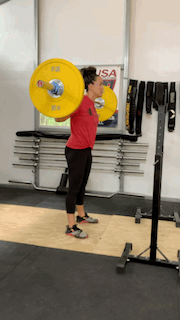
Front Squat
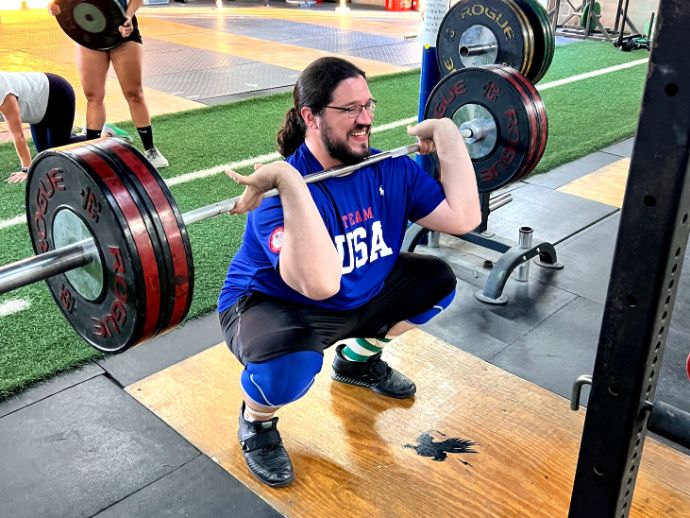
Just like back squats, front squats are still a foundational movement pattern, except the load is supported by the front of your body instead of the backside. Lots of people avoid front squats, and they do so because they just don’t like them. And we can’t blame ‘em—front squats are painful! I don’t like promoting the “no pain, no gain” culture, but honestly, you’ll rarely walk away from a set of front squats without a burn. Just know you’ll be a better person for it.
What muscles do front squats work?
The primary movers are the same as for back squats: quads, hamstrings, hip abductors, and adductors. However, you’ll find that front squats require more core engagement and also tax your shoulders, arms, lats, and upper back significantly more than back squats. This is due to the front-rack position of the bar.
Benefits of the front squat
In addition to gaining strength and muscle in your legs, front squats have the added benefit of sparing your lower back from a load it may not be ready for. By displacing the weight onto the anterior (front) side of your body, you basically force your body to use your legs and core—not your back—to lift the weight.
How to do the barbell front squat:
- Setup: Just like for back squats, rack your barbell on a squat stand or power cage. You may have to lower the J-cups slightly because you’re unracking the bar onto the front of your body now.
- Starting position: Unrack the barbell into the front-rack position (bar rests across front of shoulders; elbows point forward, palms face upward; and fingers wrap around the top of the bar). Position your feet hip- to shoulder-width apart and engage your core.
- Eccentric (lowering) phase: Just like back squats, descend to your deepest range of motion without tipping forward or bringing your heels up from the ground. Keep your elbows parallel to the ground and your eyes forward.
- Concentric (standing) phase: Drive through your heels to stand up, pushing your knees outward to avoid caving in.
- Finish: Fully extend your hips at the top and carefully re-rack the barbell.
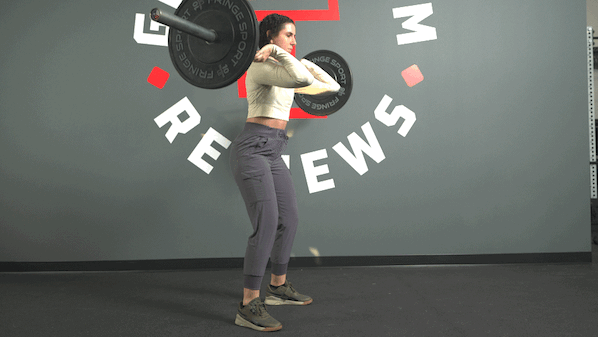
Best Barbell Overall
Rogue Ohio Bar
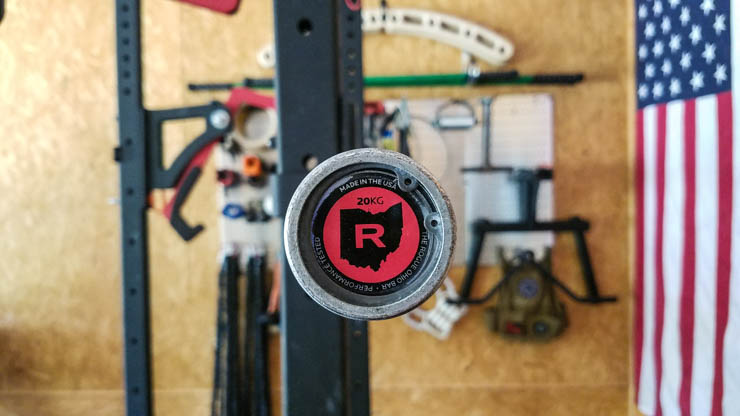
Product Highlights
- 190K PSI tensile strength
- Multipurpose bar with great versatility
- Lifetime warranty
- Bushing sleeves
- Snap ring design
Pros & Cons
Pros
- Made in the USA of US-Sourced Steel
- Somewhat passive knurling
- Grips with chalk
- Great for a variety of training styles
- Dual knurl marks
- 28.5-mm shaft
- Bronze bushings
- Lifetime warranty
- Coatings include stainless steel, Cerakote, black zinc, and more.
- 190K tensile strength
Cons
- Not outstanding for powerlifting or weightlifting in comparison to more specialized bars
- Expensive
- Diameter doesn't meet IWF standards
- No center knurl, which may matter to some
Bottom Line
The Rogue Ohio Bar is one of the most iconic barbells in the world. It's been used at the CrossFit Games by some of the fittest athletes in the world and is just as well suited in your garage gym. The Ohio Bar is priced well despite its features and being made in the USA. Although we prefer the Rogue 2.0 Bar for its price, we don't blame you if you decide to spring for the Ohio Bar, although we'd suggest getting the Stainless Steel or Cerakote version.
Barbell Romanian Deadlift
The almighty deadlift: The epitome of “pick heavy things up, put them down.” The deadlift is perhaps the simplest, yet still sexiest, lift of them all. Don’t confuse simplicity with ease, though, Amanda warns. Just because the deadlift looks easy doesn’t mean it is, and there’s actually a lot that can go wrong (especially when you’re going heavy). Follow our tips and step-by-step instructions below to master the deadlift.
What muscles do deadlifts work?
All of them. Every last muscle. Even the tiny ones you didn’t know you had. If you think you’re just working your lower back, you’re doing it wrong. Kidding… but not.
When you do deadlifts, you should feel it in your glutes and hamstrings more than your lower back. And if you’re doing heavy deadlifts, you’ll also feel it in your upper back, traps, forearms, core, shoulders, lats, and every other part of your body that helps to support the weight of the barbell as you pull it off of the ground.
That said, your primary movers for the deadlift are the muscles responsible for hip extension: hamstrings and glutes.
RELATED: Best Back Workouts
Benefits of the Romanian deadlift
People who deadlift well can also do a lot of other things well that the average person struggles with. Take moving for example. How much easier do you think moving a couch or a king-sized mattress is for someone who deadlifts versus someone who doesn’t?
Deadlifts develop strength and muscle mass in your hamstrings, glutes, and back—and more importantly, practicing deadlifts teaches you how to use that strength safely and properly.
How to do the Romanian deadlift:
- Setup: Load a barbell with weight plates on the floor. Use standard-sized Olympic plates for the best deadlift bar setup.
- Starting position: Walk up to the barbell like you’re about to absolutely hulk-smash it. Position your feet so that the bar hovers over your midfoot and sits close to your shins. Your feet should be stacked beneath your hips. Hinge at the hips and grip the barbell (double overhand grip for badasses and reverse grip for babies…) with your hands just outside your legs.
- Concentric (lifting) phase: Drive through your heels and engage your glutes and hamstrings to pull the weight off of the ground. Keep your spine in the neutral position (no arching or rounding) and push your hips forward until you reach full hip extension.
- Eccentric (lowering) phase: With control and maintaining your neutral spine, lower the barbell back to the ground by hinging at your hips, then your knees, to create one fluid motion.
- Finish: The rep is finished once the weight plates touch the ground; you can either do touch-and-go reps or reset entirely.
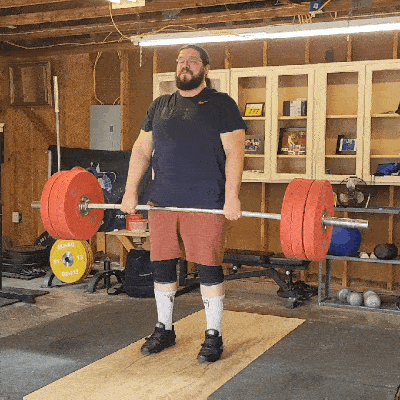
How to do sumo deadlifts:

- Setup: The setup is the same as for conventional deadlifts—use Olympic weight plates and load the bar on the ground.
- Starting position: Common among powerlifters, sumo deadlifts recruit more from the glutes than the hamstrings. Assume a wide (very wide) stand with your feet. Think about it like you’re going to do a standing straddle stretch. Position the bar so it hovers above your midfoot and sits very close to your shins. Grip the barbell with your hands shoulder-width apart, in between your legs.
- Concentric (lifting) phase: Squeeze your glutes and pull the bar off the ground using strength from your hamstrings and glutes. Keep the bar close to your body and pull until you reach full hip extension.
- Eccentric (lowering) phase: After you fully stand up with the weight, lower it back to the ground.
- Finish: Continue with touch-and-go reps, reset for another rep, or walk away like the bomb diggity if you just finished your set.
Hip Thrust

There’s one unspoken rule about hip thrusts: Don’t make eye contact with anyone doing them. So it’s a good thing you have a home gym because no one will be there to awkwardly shuffle by you as you grunt out your last set of hip thrusts.
What muscles do hip thrusts work?
Despite being a totally awkward exercise, hip thrusts are one of the best for developing lower body strength and gaining muscle, specifically in the glutes. All of your glute muscles (maximus, medius, minimus) get some action here. Your hamstrings also contribute, and your quads, core, and back acts as stabilizing and supporting muscles.
Benefits of the hip thrust
Well, there’s the obvious benefit: a nice butt. A lot of people do hip thrusts solely for that reason. They’re arguably the best exercise for targeting the glute muscles with heavy weight. However, hip thrusts offer non-aesthetic benefits, too. For starters, they’re great for developing the power needed for Olympic weightlifting (snatches and clean and jerks). They also play a role in eliminating muscle imbalances, and lots of coaches will program them for athletes who display quad dominance.
How to do the hip thrust:
- Setup: You’ll need a bench or box (recommend padding a box) along with your barbell and weight plates. Set up the bench or box so it’s sturdy and level. Use a bar pad or folded yoga mat to protect your hip bones from the weight of the bar.
- Starting position: Sit on the ground with your upper back resting against the bench. Roll the barbell toward your hips and position it so that it hovers above the crease of your hips. Put both hands on the bar; press your back into the bench; lift your hips so the barbell hovers above the ground; and position your feet at a comfortable distance from from the bench, keeping them slightly wider than hip-width apart.
- Concentric (lifting) phase: Squeeze your glutes and press your hips upward to lift the barbell. The range of motion on this exercise is fairly small, so you may not feel like you move very far. Squeeze until your hips fully extend and your body makes a bridge with the ground. Be careful not to hyperextend your back.
- Eccentric (lowering) phase: Slowly lower the bar back to the starting position by bending your hips. Make sure to keep your feet flat on the floor and keep your core engaged throughout the entire movement.
- Finish: Once you finish your set, carefully lower yourself and the barbell to the ground and roll the barbell away so you can stand up.
Overhead Press
Press it overhead, bring it back down. Simple enough, right? Actually, many people are surprised to learn that the overhead press is one of the most challenging barbell exercises and that a lot more goes into it than simply extension of the arms.
What muscles do overhead presses work?
Your deltoids are primarily responsible for pressing a barbell overhead. Your triceps and pecs also play a role in the pressing motion, while your back muscles (especially your lats) help to control the barbell on the descent. Your core and glutes should also be isometrically involved the entire time to keep your spine where it needs to be.
Benefits of overhead presses
Boulder shoulders, dudes! The classic overhead press—also called strict press or military press—develops the delts like few other movements. In addition to aesthetics, overhead presses can help improve shoulder mobility and upper back mobility, as well as strengthen the muscles that protect delicate shoulder joints from damage.
How to do overhead presses:
- Setup: Set up a bar and weights on a squat stand or power cage at a height you can comfortably unrack it from.
- Starting position: Unrack the barbell into the front-rack position and step back from the stand. Plant your feet firmly, take a deep breath, and brace your core. Keep in mind that the front-rack position here is different than in front squats. For strict presses, you’ll want to point your elbows slightly outward and down at about 45 degrees, versus forward and at 90 degrees in the front squat.
- Concentric (pressing) phase: Keeping your gaze forward and spine neutral (no hyperextending), press the barbell overhead until your elbows fully extend.
- Eccentric (lowering) phase: Bend at the elbows to lower the bar back to your collarbones—with control, lest you wake up with bruises you have to explain to your mom and your significant other.
- Finish: As soon as the bar makes contact with your shoulders/collarbone, you can go in for another rep. When you’re done, re-rack the bar or drop it to the hang position (holding at the hips) before dropping it to the floor.
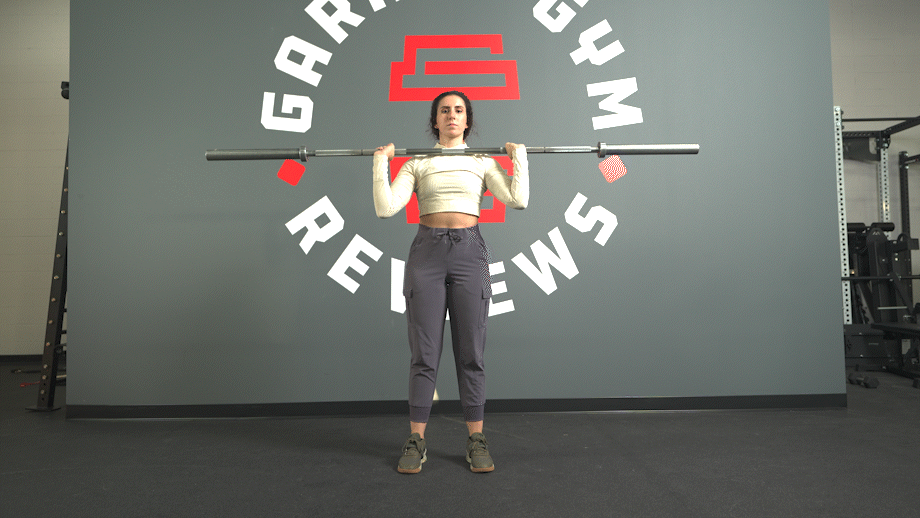
Bench Press
A staple in powerlifting and bodybuilding alike, the bench press is probably the most dude-bro lift of all time. This is for good reason: It’s one of the most effective exercises for strength and hypertrophy in the upper body.
What muscles does bench press work?
Prime movers during bench press include your pecs, triceps, and anterior deltoids (front of your shoulders). Your lats are involved in the lowering portion of the lift.
Benefits of the barbell bench press
The humble bench press grows your pecs, deltoids, and triceps, and it also shreds your serratus muscles—those small muscles that sit atop your upper ribs and make you look absolutely shredded when they’re visible. More importantly, the bench press improves your upper body pushing strength, which would come in handy if you ever ran out of gas and had to push a car or something.
How to do the barbell bench press:
- Setup: Slide your bench into position in the middle of your power rack. Rack the barbell and weights at a height you can comfortably reach from the bench.
- Starting position: Positioning for bench press varies a lot among people, but in general, you should situate yourself on the bench so that you can reach the bar without locking out your elbows (because you’ll need some leverage to unrack it), and so that your feet can touch the floor. Grip positioning varies based on anatomy and preferences, but should fall around shoulder-width.
- Eccentric (lowering) phase: Unrack the bar and hold it above your chest with your elbows fully extended. Keeping your wrists strong, bend at the elbows to lower the barbell until it touches your chest. The barbell should make contact somewhere between the lower pec muscles and sternum. Generally, the narrower your grip, the lower on your torso that contact point will be.
- Concentric (pressing) phase: Recruit your pecs, shoulders, and triceps to press the bar back up to the starting position.
- Finish: The rep is complete when your elbows fully extend. Rerack the bar by guiding it backward into the J-cups on your power rack.
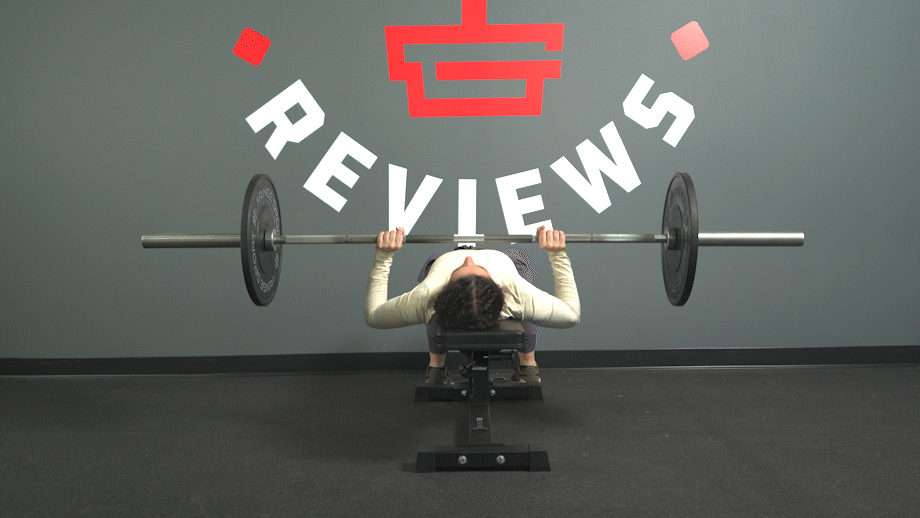
Bent Over Row
Bent-over rows are a must-have in your routine for strong, developed back muscles. They’re simple but effective.
What muscles do bent-over rows work?
Your lats and spinal erector muscles are the main movers for the barbell bent-over row. Many other muscles directly support the rowing movement pattern, including your rhomboids (which retract your shoulder blades), traps (which depress and raise your shoulder blades), your deltoids, biceps, and other small muscles throughout your back. Your hips and glutes are engaged isometrically while you’re in the hip-hinge position.
Benefits of the barbell bent-over row
Bent-over rows are ideal for increasing strength in your upper and mid-back, which can transfer to the skills you need for movements like pull-ups. Developing those upper and mid-back muscles also assists your ability to hold onto the bar during heavy deadlifts and complete the pull-on power cleans and snatches.
How to do the barbell bent-over row:
- Setup: Load a barbell on the ground with Olympic weight plates.
- Starting position: Stand with your feet beneath the barbell as if you’re setting up for a deadlift. Grab the bar with a double overhand grip (double underhand if you want to target more biceps and rhomboids), with your hands shoulder-width apart and palms facing down. You should be in a hip-hinge position with your back straight.
- Concentric (rowing) phase: Think about squeezing your shoulder blades together. Pull the barbell toward your torso and try to tap it to your sternum. Your elbows should travel backward and point to the sky behind you. Palms remain facing down.
- Eccentric (lowering) phase: Extend your arms to lower the barbell back to the starting position.
- Finish: There’s no real resetting for this exercise; simply go in for another rep after you lower the bar.
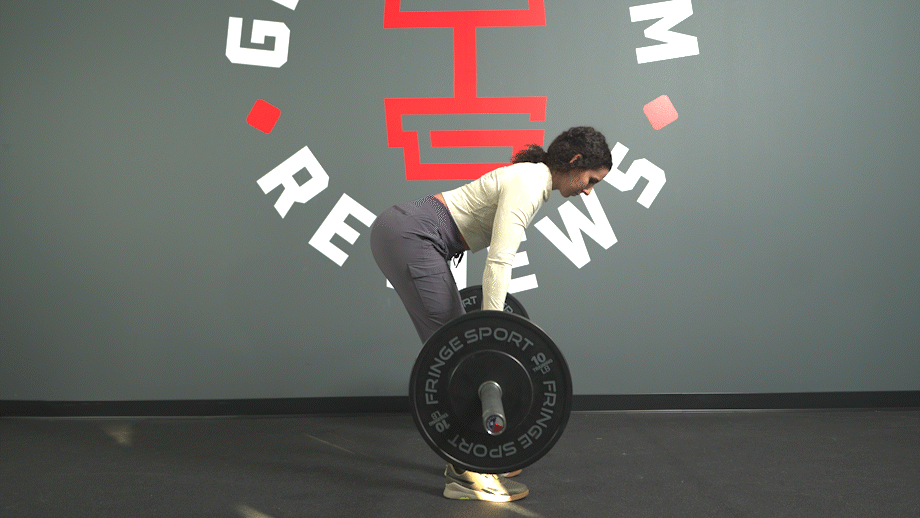
Best Multipurpose Budget Barbell
Fringe Sport Wonder Bar V2 20KG Barbell
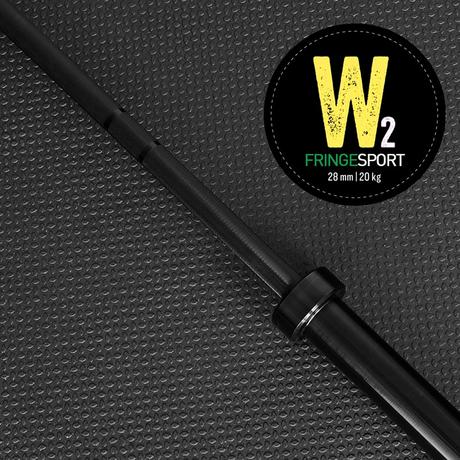
Product Highlights
- Ideal as a multi-purpose bar
- Dual knurl marks
- 205,000 PSI
- Fringe Sport has free shipping
- Lifetime warranty
Pros & Cons
Pros
- Knurling is somewhat passive
- Ideal as a multi-purpose bar
- Dual knurl marks
- 205,000 PSI
- Bearings or bushing are available
- 28MM in diameter
- Fringe Sport has free shipping
- Lifetime warranty
Cons
- Black zinc finish will fade over time
- Sleeves prone to scarring rather quickly
- Not made in USA
Bottom Line
The Fringe Sport Wonder Bar V2 is one of the best value general training/CrossFit barbells on the market that we've reviewed. For under $200 you get a crazy good spec sheet and a barbell that will perform in any workouts for as long as you keep it. If you're on a budget, but want a great barbell, we suggest this one.
Benefits of Barbell Training
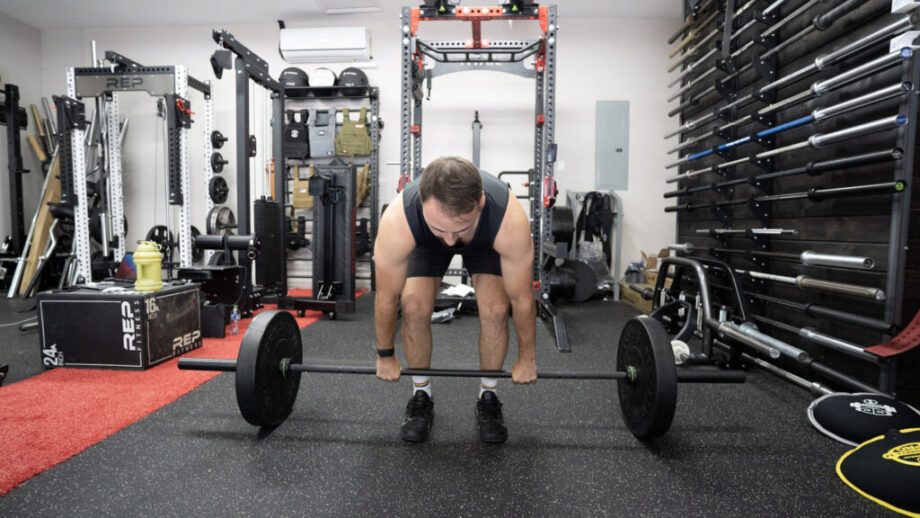
A barbell is perhaps the most versatile, and arguably the most important, piece of fitness equipment of all. With a barbell, you can do all of the compound exercises described above, as well as countless other multi-joint and single-joint (isolation) exercises. Below, Amanda and I dive into the main benefits of barbell training.
Increased Strength
Captain Obvious reporting for duty! You probably already knew or, at the very least, suspected that barbell training increases strength. That’s kind of the whole point. All types of weight training can help you get stronger, but barbells are more conducive to multi-joint lifts than dumbbells, kettlebells, cables, or other equipment.
“Things like technique, load, rep scheme, volume, and, of course, genetics all affect how quickly you’ll gain strength from barbell training,” Amanda says, “but the important thing is that you’re training with a barbell. If you are, it means you’re in the best position to do the big compound lifts that are best for gaining strength.”
Power and Explosiveness
In addition to raw strength, you can develop power and explosiveness if you have a barbell and some weight plates. These two skills involve fast-twitch muscle fibers and are important for movements like power cleans, jerks, snatches, throwing, sprinting, and jumping.
You’re not alone if you think these things aren’t important, Amanda says, because most people think power and explosiveness are reserved for CrossFitters or elite athletes. In actuality, these two attributes help you develop a well-rounded arsenal of athleticism.
Hypertrophy
Yup, you can totally get jacked with just a barbell and weight plates. While dumbbells, kettlebells, resistance bands, and specialty equipment help with muscle isolation, there are plenty of barbell exercises you can do to increase muscle mass.
As a matter of fact, you can get all the gainz you need just by doing the best barbell exercises we covered above. “With barbell training, it doesn’t have to be complicated,” Amanda reminds. “Do some pushing, some pulling, some squatting, and some hinging, and you’ll be well on your way to a more muscular physique.”
Health and Wellness
On top of all those fitness benefits, the health benefits of barbell training can’t be overlooked. “Most people pick up a barbell because they want to get strong or ripped, but they eventually learn the benefits run much deeper than that,” Amanda says.
Health benefits of barbell training include:
- Increased bone density and reduced risk of osteoporosis
- Protection against osteoarthritis and joint pain
- Increased lean body mass
- Reduced risk of cardiovascular disease
- Improved mood and increased energy levels
- Improved mobility and flexibility
- Increased resting metabolic rate
Coordination, Balance, and Stability
It doesn’t matter what amount of weight you use while barbell training: Practicing the best barbell exercises above will improve the way you move in everyday life as well as other recreational pursuits. Barbell training increases body awareness, which helps you develop coordination, balance, and stability (which is especially important as you get older).
Versatility
Finally, barbell training is extremely versatile. This isn’t necessarily a physical health or fitness benefit like the others, but it’s worth calling out. Because barbell training is so versatile, you’re less likely to get bored with it compared to training solely with dumbbells or machines. There’s always something new to try with a barbell. Also, you can basically progress endlessly—as long as you have enough weight plates, that is.
Best Bumper Plates
REP Black Bumper Plates
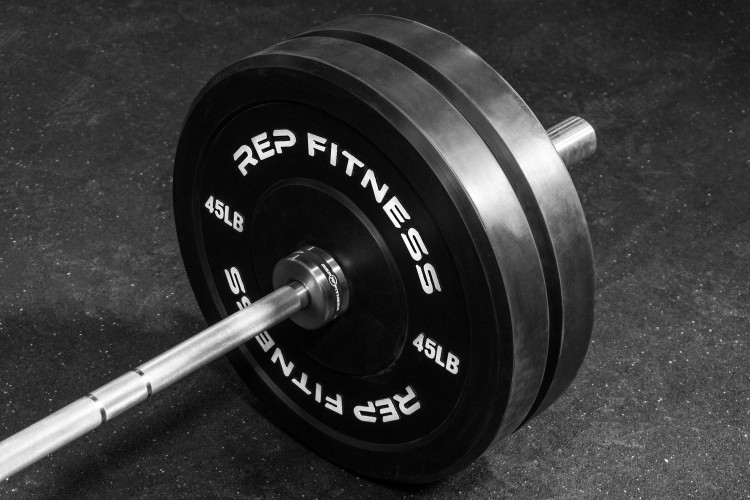
Product Highlights
- Extremely durable and attractive
- Ideal for cross-training and Olympic weightlifting
- 10-lb plates are extra thick (1″) to increase durability
- 45-lb plates are thinner than most at 2″
Pros & Cons
Pros
- Extremely durable and attractive
- Ideal for cross-training and Olympic weightlifting
- 10-lb plates are extra thick (1") to increase durability
- 45-lb plates are thinner than most at 2"
Cons
- 3% weight tolerance is pretty high
- Like many rubber bumpers, may smell a little for some
- No 55-lb option
Bottom Line
The REP Black Bumper Plates are extremely durable and feature a thick 10-lb plate meant to withstand drops.
Final Verdict
As you can see, the best barbell exercises are those that utilize multiple joints and muscle groups at once—they’re all compound exercises. You probably noticed a common theme: While all of the best barbell movements have a group of primary movers, the truth is, your entire body is engaged during each and every one of them. That’s why these are superior for building full-body strength and supporting muscle growth.
Of course, there are a ton of other great barbell exercises out there. At Garage Gym Reviews, some of our favorites include Romanian deadlifts, split squats, power cleans, snatches, good mornings, and lunges (especially of the walking variety if you’re Amanda; we may or may not think she’s a sociopath). But we stand by our stance that the fundamentals remain the best for most people.
Barbell Exercises FAQs
Can you build muscle with just a barbell?
Barbell training is one of the best ways to build muscle. You can absolutely build muscle with a just barbell, although most people will outgrow a 35- or 45-pound bar pretty quickly. It helps to have weight plates, of course. With a barbell and plates, you can continually challenge yourself by adding weight, and your body will respond by building more muscle.
What muscles do barbells work?
You can work literally any and every muscle with a barbell. You can do compound exercises or isolation exercises to target specific muscle groups or work your whole body. There are virtually endless options for lower body and upper body barbell exercises for you to choose from.
What is the hardest barbell exercise?
The hardest barbell exercise is relative—what’s hard for one person may not be hard for the next. In general, people struggle more with compound exercises due to the necessary mobility aspect. For example, it’s common for people to struggle to reach full depth on barbell squats or struggle to lock their arms out in an overhead press.
Do barbell squats burn fat?
While you can’t burn fat from your stomach just, squatting burns fat while also building muscle. Heavy squats improve your lean muscle mass, which enhances your capacity to burn calories at rest throughout the day. While squats primarily develop strength and power, heavy squats increase your lean muscle mass, which increases your ability to burn calories at rest throughout the day.
References
Krzysztofik M, Wilk M, Wojdała G, Gołaś A. Maximizing Muscle Hypertrophy: A Systematic Review of Advanced Resistance Training Techniques and Methods. Int J Environ Res Public Health. 2019;16(24):4897. Published 2019 Dec 4. doi:10.3390/ijerph16244897
Westcott WL. Resistance training is medicine: effects of strength training on health. Curr Sports Med Rep. 2012;11(4):209-216. doi:10.1249/JSR.0b013e31825dabb8
Joshua AM, D’Souza V, Unnikrishnan B, et al. Effectiveness of progressive resistance strength training versus traditional balance exercise in improving balance among the elderly – a randomised controlled trial. J Clin Diagn Res. 2014;8(3):98-102. doi:10.7860/JCDR/2014/8217.4119
Schoenfeld BJ, Peterson MD, Ogborn D, Contreras B, Sonmez GT. Effects of Low- vs. High-Load Resistance Training on Muscle Strength and Hypertrophy in Well-Trained Men. J Strength Cond Res. 2015;29(10):2954-2963. doi:10.1519/JSC.0000000000000958
Grgic J, Schoenfeld BJ, Davies TB, Lazinica B, Krieger JW, Pedisic Z. Effect of Resistance Training Frequency on Gains in Muscular Strength: A Systematic Review and Meta-Analysis. Sports Med. 2018;48(5):1207-1220. doi:10.1007/s40279-018-0872-x
Further reading

The best workout leggings are moisture-wicking, breathable, and stretchy enough to comfortably move with you. Here are our top picks. Read more

Wanting to learn more about this discontinued elliptical? Get all your questions answered with our NordicTrack CX 998 Elliptical review. Read more

The VersaSpot Dumbbell Spotter System is essentially a J-Hook System for your dumbbells. This allows you to press out of the rack without having to start the press from your chest. It works extremely well, protects your dumbbells and is easy to adjust. If you do a lot of heavy dumbbell presses, we recommend the system. Read more

If water is king for healthy hydration then electrolytes are queen. Find the best electrolyte drink list here, all supported and tested by nutrition experts. Read more

